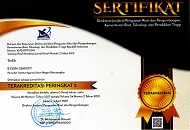Academic Burnout Among Students During the COVID 19 Pandemic: a Gender-Based Analysis
Abstract
Academic burnout among FKIP UHAMKA students will be analyzed based on gender. A descriptive approach is utilized in the quantitative research methodology. A sample of 307 students was chosen from the 6,544 total pupils who participated in the research. According to the study's findings, academic burnout can be classified according to a person's gender. The researchers discovered that male students fell into the low category, scoring 75% in sub-variable exhaustions, 61% in cynicism, and 50% in inefficacy. Additionally, the majority of female students fall into the low category, with percentage values in the subvariables for weariness (76%), cynicism (63%), and inefficacy (64%) all falling into the low range. Thus, it can be said that both male and female students at FKIP UHAMKA have low levels of academic burnout.
Keywords
Full Text:
PDFReferences
Fitriani, W., Asmita, W., Hardi, E., Silvianetri, S., & David, D. (2022). Kuliah Daring: Tingkat Stres Akademik pada Mahasiswa dan Faktor yang Mempengaruhinya. Edukasi Islami: Jurnal Pendidikan Islam, 11(01), 147. https://doi.org/10.30868/ei.v11i01.1869
Fyana, L., & Rozali, Y. A. (2020). Perbedaan Burnout Ditinjau dari Jenis Kelamin pada Karyawa Bank ABC. JCA of Psychology, 1(02).
Gold, Y., & Roth, R. A. (2013). Teachers managing stress & preventing burnout. Routledge.
Khairani, Y., & Ifdil, I. (2015). Konsep Burnout pada Mahasiswa Bimbingan dan Konseling. Konselor, 4(4), 208. https://doi.org/10.24036/02015446474-0-00
Leiter, M. P., & Maslach, C. (2003). Areas of worklife: A structured approach to organizational predictors of job burnout. In Emotional and physiological processes and positive intervention strategies. Emerald Group Publishing Limited.
Maslach, C. (2003). Job burnout: New directions in research and intervention. Current Directions in Psychological Science, 12(5), 189–192.
Mudjahid, Q. (2017). Pengaruh Karakter Kerja Keras terhadap Academic Burnout Mahasiswa yang sedang Menempuh Skripsi pada Perguruan Tinggi Swasta di Kabupaten Banyumas. Universita Muhammadiyah Purwokerto.
Portnoy, D. (2011). Burnout and Compassion Fatigue: Watch for the Signs. Health Progress (Saint Louis, Mo.), 92(4), 46–50.
Schaufeli, W. B., Martínez, I. M., Pinto, A. M., Salanova, M., & Barker, A. B. (2002). Burnout and engagement in university students a cross-national study. Journal of Cross-Cultural Psychology, 33(5), 464–481. https://doi.org/10.1177/0022022102033005003
Wahyu, A., & Simanullang, R. H. (2020). Student Stress Due to Online Learning During the Covid-19 Pandemic. Jurnal Aisyah: Jurnal Ilmu Kesehatan, 5(2), 153–157.
Zhang, Y., Gan, Y., & Cham, H. (2007). Perfectionism, academic burnout and engagement among Chinese college students: A structural equation modeling analysis. Personality and Individual Differences, 43(6), 1529–1540.
DOI: http://dx.doi.org/10.31958/jt.v25i2.6557
Refbacks
- There are currently no refbacks.
Copyright (c) 2022 Dony Darma Sagita

This work is licensed under a Creative Commons Attribution-NonCommercial 4.0 International License.
TA'DIB with registered number e-ISSN: 2580-2771, p-ISSN: 1410-8208 have been indexed on:

Journal Ta'dib distribute under Lisensi Creative Commons Atribusi-NonKomersial 4.0 Internasional.
Contact us: Ta'dib; Address: FTIK, Universitas Islam Negeri Mahmud Yunus Batusangkar; Jl. Sudirman No. 137 Lima Kaum Batusangkar, Tanah Datar, Sumatera Barat, Indonesia. Email: takdib@uinmybatusangkar.ac.id

























